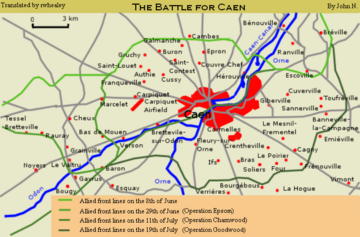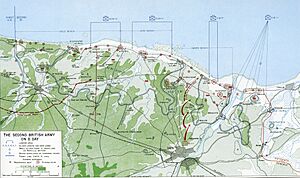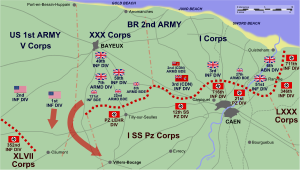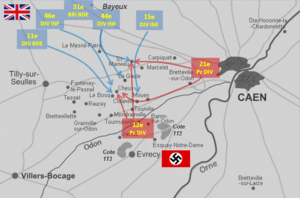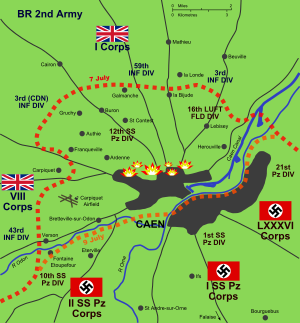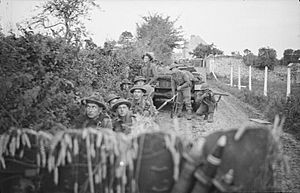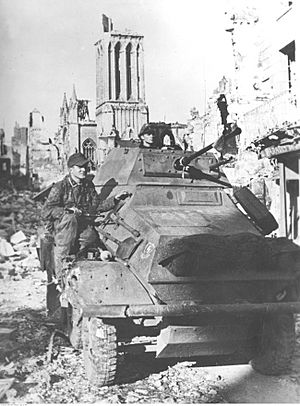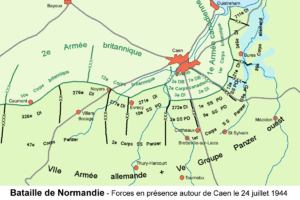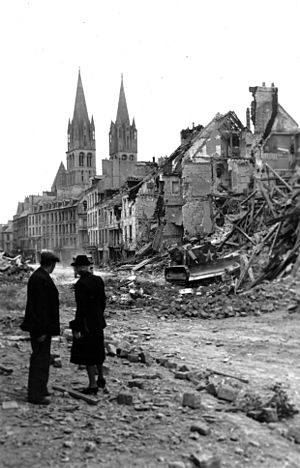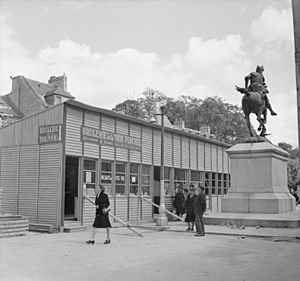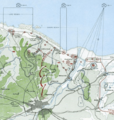Battle for Caen facts for kids
Quick facts for kids Battle for Caen |
|||||||
|---|---|---|---|---|---|---|---|
| Part of Operation Overlord | |||||||
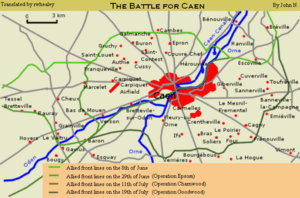 Battle for Caen |
|||||||
|
|||||||
| Belligerents | |||||||
| Commanders and leaders | |||||||
|
|
||||||
| Strength | |||||||
| 3 armoured divisions 10 infantry divisions 1 airborne division 5 armoured brigades 3 tank brigades 2 commando brigades |
7 infantry divisions 8 panzer divisions 3 heavy tank battalions |
||||||
The Battle for Caen was a series of fierce fights during World War II in 1944. It took place between the British and Canadian armies and the German army, called Panzergruppe West. The battle was for control of the city of Caen and the areas around it in Normandy, France. This fighting happened right after Operation Neptune, which was when the Allies landed on the French coast on D-Day, June 6, 1944.
Caen is about 9 miles (14 km) inland from the coast. It sits on the Orne River and Caen Canal. Many important roads and railways meet there. This made Caen a very important target for both sides. The land around Caen to the south is flatter and more open than other parts of Normandy. Allied air force leaders wanted to capture this area quickly. This would allow them to set up more airfields in France.
The British 3rd Infantry Division was supposed to capture Caen on D-Day itself. If they couldn't, they were to dig in close to the city. This would keep the Germans worried about Caen and stop them from attacking back from the city.
However, Caen, Bayeux, and Carentan were not captured by the Allies on D-Day. For the first week, the Allies focused on connecting their landing spots on the beaches. British and Canadian forces then restarted their attacks near Caen. The northern parts of the city were captured during Operation Charnwood (July 8–9). The southern parts of Caen, across the river, were taken by Canadian forces during Operation Atlantic (July 18–20). The Germans had sent most of their powerful tank divisions to defend Caen. This made the fighting very costly for both sides. It also meant the Germans couldn't send these tanks to other parts of the invasion front.
In western Normandy, the US First Army cut off the Cotentin Peninsula and captured Cherbourg. They then attacked south towards Saint-Lô, about 37 miles (60 km) west of Caen. Saint-Lô was captured on July 19. On July 25, after a delay due to bad weather, the US First Army started Operation Cobra. This attack was planned with the Canadian Operation Spring south of Caen. Operation Cobra was a huge success. It began the collapse of the German defenses in Normandy. This Allied breakthrough led to the Battle of the Falaise Pocket (August 12–21). Most of the remaining German armies were trapped there. This opened the way for the Allies to advance towards the Seine River and Paris.
Caen was heavily damaged by Allied bombing and ground fighting. Many French civilians were killed. After the battle, very little of the city was left standing. It took until 1962 to rebuild Caen.
Contents
Why the Battle Happened
British Plans for Normandy
Britain had joined the war in 1939 to keep things balanced in Europe. Just winning wasn't enough; they wanted to make sure they had a say after the war, especially with the rise of the USA and USSR as superpowers. The British army wanted to play a big part in defeating Germany. This would help them have influence later. They also wanted to save their soldiers from too many casualties. The British economy was fully focused on the war, and there weren't many new soldiers available. Many British and Canadian commanders had fought in World War I. They hoped that using new technology and lots of firepower could avoid another long, bloody fight.
Secret Intelligence: Ultra
The Allies had a secret weapon: they could read German messages. These messages were coded using a machine called Enigma. The British codebreakers at Bletchley Park called this secret information "Ultra." By mid-1943, the Allies could regularly read these messages. This helped them understand German plans and how well their own tricks were working. For example, in March 1944, Ultra showed that the Germans expected an invasion anywhere from Norway to Spain. This secret information was very helpful for the Allied commanders.
The Overlord Plan
In December 1943, General Dwight D. Eisenhower became the top Allied commander. The invasion plan, called Operation Overlord, was led by General Bernard Montgomery. The plan involved three British divisions landing on beaches called Gold, Juno, and Sword. Three US divisions would land on Omaha and Utah beaches. Three airborne divisions would land further inland.
The US forces in the west were to capture the port of Cherbourg. Then, they would expand the landing area towards the Loire River. The British and Canadian forces on the eastern side would face the main German forces. They would also deal with German reinforcements coming from the east. The plan was for armored forces to quickly move past Caen, Bayeux, and Carentan. They would capture the high ground southeast of Caen, which controlled the main roads. They also aimed to take the crossings over the Odon and Orne rivers.
British Second Army's Role
General Montgomery held a planning exercise in April 1944. The goal was to capture a landing area that included airfields and the port of Cherbourg. Montgomery expected the Germans to quickly send many tanks to Normandy within four days. He thought they would try to counter-attack the landing beaches. But he believed the German attack would fail. Then, the Germans would have to switch to defending their positions.
The British and Canadian divisions were to land west of the Orne River. An airborne division would land east of the river. Their job was to capture the Orne bridges at Benouville and Ranville. The Anglo-Canadians would then move south and southeast. They would capture land for airfields and protect the US First Army's eastern side as it attacked Cherbourg.
German Defensive Plans
German commanders, Field Marshal Erwin Rommel and Field Marshal Gerd von Rundstedt, disagreed on how to stop the invasion. They argued about where to place their tank divisions. Rundstedt wanted to keep the mobile forces far back. He would wait until the main Allied attack was clear. Then, he would use these forces to push the Allies off the continent. General Leo Geyr von Schweppenburg, who commanded the tank forces, agreed with Rundstedt.
Rommel had seen how powerful Allied air forces were in North Africa. He believed that generals who had fought on the Eastern Front didn't understand how much Allied air power would affect the battle. He thought that Allied planes would attack German reserve forces as they moved. This would delay them and stop them from defeating the invasion. Rommel believed that only a quick counter-attack right when the Allies landed had a chance. So, he wanted the tank divisions much closer to the coast.
In April 1944, Adolf Hitler made a compromise. Some tank divisions were placed under Rommel's command, closer to the coast. Others were kept further back under Hitler's direct control. This meant the central reserve was too small for Rundstedt's plan. Also, not enough tank divisions were close enough for Rommel's plan.
The Atlantic Wall Defenses
Hitler was in charge of Germany's defenses on the Western Front. Since 1940, they had been building strong defenses, especially around ports. After a failed British raid in 1942, Hitler ordered more fortifications. Rommel was sent to inspect the coastal defenses.
The Germans built a "string of pearls" of steel and concrete defenses. These included strong points with overlapping fields of fire. They also built beach obstacles, anti-tank ditches, and laid huge numbers of mines. By the end of 1943, about 8,500 fortifications were built. Another 12,247 were added in northern France by D-Day. Artillery positions were moved, and fake positions were dug to trick Allied planes.
Normandy Coast Defenses
The Normandy coast near Caen has wide beaches and small harbors. It's also close to the port of Cherbourg. There's an 18-mile (29 km) stretch where landings could easily happen. In 1944, six German divisions guarded the coast from the Seine to Cherbourg. Four of these were smaller coastal defense divisions. The 21st Panzer Division (a tank division) also supported them.
On Sword Beach, thousands of obstacles like hedgehogs, stakes, and ramps were installed. Most had mines or anti-aircraft shells attached. Beachfront buildings were fortified. Strong points were built at Franceville and Riva Bella, near the Orne River mouth. Artillery batteries were placed at Merville and south of Ouistreham.
The 716th Infantry Division guarded the German defenses from Le Hamel to Merville-Franceville-Plage. This division had about 9,343 men. They had machine guns, mortars, and anti-tank guns. A few weeks before the invasion, the division had 7,771 men. The 21st Panzer Division was moved to Caen in May. It placed its 146 tanks and 50 assault guns south of the city. Two tank-infantry battalions were placed on either side of the Orne north of the city. Its artillery was on the coast to give more defense to the 716th Infantry Division.
Getting Ready for Battle
British I Corps Plan
Before D-Day, the 6th Airborne Division carried out Operation Tonga. Their job was to capture the bridges over the lower Orne River by surprise. They would then set up a secure area on the east side of the river. This would block any German counter-attacks.
I Corps was to land with the 3rd Canadian Infantry Division on Juno Beach. They would then move south to cut the Caen–Bayeux road near Carpiquet, northwest of Caen. The British 3rd Infantry Division was to land on Sword Beach and advance directly towards Caen. If Caen was captured quickly, I Corps would take the high ground to the south. If the Germans stopped them, the corps would set up a defensive line around the city. The landings were supported by bombs from Allied planes, naval ships, and rockets from landing craft.
The Battle Begins
D-Day, June 6
The bombing and naval attacks didn't destroy German beach defenses as much as hoped. In many places, Allied soldiers, engineers, and tanks had to fight hard to move forward. The 3rd Canadian Infantry Division landed on Juno Beach. They aimed to capture Corseulles, but it took until the afternoon. Other Canadian attacks also faced strong German resistance.
On Sword Beach, the British 8th Infantry Brigade landed. The tide came in faster than expected, making the beach much smaller. This caused traffic jams for the follow-up forces. German machine guns swept the beach as the British advanced. A German strongpoint at La Brèche held out until 10:00 a.m. By 10:30 a.m., British and Canadian divisions had landed many soldiers and tanks on a beachhead only 5 miles (8 km) wide. By noon, more brigades were ashore, slowly moving through traffic jams under heavy German artillery fire.
The German response was slower than the Allies expected. Many senior German officers were away. It took ten hours for Hitler to allow the I SS Panzer Corps to move. German troops on the Calvados coast fought very hard. The British 3rd Infantry Division made quick progress from Sword Beach. But they were slowed down further inland at strongpoints like Hillman. Hillman was very well fortified and hidden. It held out until the next morning. This tied up some of the forces meant for the quick push to Caen. It also gave time for the 21st Panzer Division to move its tanks to stop the British advance.
Operation Perch (June 10–14)
Operation Perch aimed to make the Germans think the British would break out southeast of Caen. The British 50th (Northumbrian) Infantry Division would capture the road to Tilly-sur-Seulles. Then, the 7th Armoured Division would lead the advance to Mont Pinçon. On June 9, Montgomery ordered Caen to be taken by a "pincer movement." This meant attacking from two sides.
I Corps would attack from the east. XXX Corps would attack from the west. I Corps was delayed because bad weather slowed down the arrival of more divisions. Their attack was delayed until June 12. The British 51st Highland Division attacked the 21st Panzer Division, but the German defense was strong. On June 13, the attack east of Caen was called off.
On the right side of XXX Corps, the German 352nd Infantry Division was defeated. This left a 7.5-mile (12 km) gap in the German front. The British 7th Armoured Division tried to use this gap to capture Villers-Bocage. After the Battle of Villers-Bocage, the position was too risky. The 7th Armoured Division pulled back on June 14. A severe storm hit the English Channel on June 19. It damaged the Mulberry harbours (temporary ports) and made it even harder to unload supplies and reinforcements.
Operation Epsom (June 26–30)
On June 25, XXX Corps launched Operation Martlet. This was a smaller attack before the main effort, Operation Epsom. It aimed to take Rauray village and other nearby areas. The Germans had strong defenses there. By the end of the day, the British had reached some woods, but the Germans still held Rauray. The next day, the British captured Tessel-Bretteville but lost it to a counter-attack. Reinforcements arrived for the Germans. On June 27, the British took Tessel-Bretteville wood and Rauray. Fighting continued in the area during Operation Epsom.

Operation Epsom began on June 26. Its goal was to capture the high ground south of Caen, near Bretteville-sur-Laize. The newly arrived VIII Corps led this attack. The operation was supported by 736 guns, the Royal Navy, and air support. The British 15th (Scottish) Infantry Division made steady progress. By the end of the first day, they had taken much of the German outpost line. Over the next two days, they secured a foothold across the Odon River. German counter-attacks forced a withdrawal from some British positions by June 30.
VIII Corps had advanced almost 6 miles (10 km). The Germans used their last reserves to stop the British attack. This was a costly success for them. It also meant no German tank forces could be sent to fight the US First Army. From June 26 to 30, the British Second Army had about 4,078 casualties. The Germans lost over 3,000 men and 126 tanks.
The airfield at Carpiquet, near Caen, was a D-Day target for the 3rd Canadian Infantry Division. But the 12th SS Panzer Division got there first. They occupied the airfield's strong defenses. A Canadian operation to take Carpiquet was delayed. For Operation Windsor, the 8th Canadian Infantry Brigade was strengthened. The Canadians took Carpiquet village with help from the French Resistance on July 5. Three days later, they captured the airfield and nearby villages during Operation Charnwood.
Operation Charnwood (July 8–11)
Three infantry divisions and three armored brigades of I Corps were to attack south through Caen to the Orne River. They aimed to capture bridgeheads (secure areas) in the parts of Caen south of the river. An armored column was ready to rush through the city to take the bridges. This would open the way for the Second Army to advance towards Falaise. New tactics were tried, including a huge bombing by Allied planes before the attack. This was to help the Anglo-Canadian advance and stop German reinforcements.
On the evening of July 7, bombers dropped over 2,000 tons of bombs on the city. The bombing was aimed more at the city than at German defenses to avoid hitting their own troops. The ground attack began at 4:30 a.m. on July 8. By evening, I Corps had reached the edge of Caen. The Germans began to pull back their heavy weapons and soldiers to the southern side of Caen. The remaining soldiers of the 12th SS Panzer Division fought a rear-guard action, then retreated over the Orne.
The 12th SS Panzer Division pulled back during the night. Early on July 9, British and Canadian patrols entered the city. Canadians occupied Carpiquet airfield. By noon, Allied soldiers had reached the north bank of the Orne. Some bridges were still standing but were blocked by rubble. German troops on the south bank were ready to counter-attack. After the battle, French civilians came out of their homes, realizing the city was taken.
Operation Jupiter, an VIII Corps attack, began on July 10. It aimed to follow up a possible German retreat after Charnwood. The Germans had five infantry battalions, Tiger tanks, and other armored vehicles. The attack was meant to capture villages and recapture the top of Hill 112. The attack began after naval bombing, air attacks, and artillery fire. But the German Tiger tanks had a longer range than British Churchill and Sherman tanks. Neither side could hold Hill 112, and its top was left in no-man's-land. Several nearby villages were taken. The 9th SS Panzer Division was sent to stop the attack. This achieved the Allied goal of keeping German forces busy.
Operation Goodwood
On July 18, VIII Corps began Operation Goodwood. This was an attack by three armored divisions towards the German-held Bourguébus Ridge. The goal was to force the Germans to use their armored reserves in costly counter-attacks. Further west, other British and Canadian attacks happened to keep German attention on the eastern side of the landing area. On July 18, I Corps advanced to secure villages and the eastern side of VIII Corps. On the western side, Canadian forces carried out Operation Atlantic to capture the remaining German positions in Caen south of the Orne.
The Germans were able to stop the British advance before Bourguébus Ridge. But they were shocked by the strength of the attack and the bombing before it. The Germans only had enough resources to hold their ground south of Caen. The southern suburbs had been captured by the Canadians in Operation Atlantic. The British had advanced 7 miles (11 km) east of Caen and took about 12,000 yards (11 km) of ground south of the city.
This attack made the Germans believe that the Allied threat on the eastern side was the most dangerous. More units were moved eastward. The British force suffered over 4,000 casualties and almost 500 tank losses. By July 25, there were 600 German tanks facing the British and Canadians, and only 150 facing the US First Army. The Germans were not destroyed, but their commanders became very discouraged.
Operation Atlantic
During the battle, the I SS Panzer Corps turned the 90-foot (27 m) high Verrières Ridge into a strong fortress. They defended it with hundreds of guns, tanks, and soldiers. On July 18, Operation Atlantic began. The 2nd Canadian Infantry Division, with tank support, captured Giberville and the industrial suburbs of Colombelles and Vaucelles south of the Orne. By mid-afternoon, two companies of the Black Watch had crossed the river. The 5th Canadian Infantry Brigade pushed south to Saint-André-sur-Orne.
With the south bank secure, Canadian brigades moved into position for the second phase: an attack on Verrières Ridge. On July 19, Cormelles was captured. The 1st SS Panzer Division and the 272nd Infantry Division counter-attacked but were pushed back. On July 20, Canadian regiments attacked the ridge. Torrential rain stopped tanks and soldiers and grounded planes. The South Saskatchewans lost 282 soldiers. German tank divisions counter-attacked and forced the Canadians back. The Essex Scottish lost about 300 soldiers. On July 21, more Canadian battalions stabilized the front along Verrières Ridge. They defeated more counter-attacks by the SS Panzer divisions in costly defensive fighting.
Operation Spring
On July 25, Canadian forces carried out Operation Spring on Verrières Ridge. This happened at the same time as the American Operation Cobra in the west. The goal was to capture the ridge and villages on its southern slope. The German defenses on the ridge and their tank counter-attacks caused heavy losses for the Canadian soldiers and tanks. The attack "fizzled out" later that day.
Aftermath and Destruction
Allied Bombing of Caen
The Allied bombing of Caen left a lasting mark on the city. Before the invasion, Caen had 60,000 people. On June 6, Allied planes dropped leaflets telling people to leave, but only a few hundred did. Later that day, British bombers attacked the city to slow down German reinforcements. About 800 civilians were killed in the first 48 hours. Streets were blocked by rubble. The injured were taken to an emergency hospital. Many historic buildings were destroyed or badly damaged. About 15,000 people hid for over a month in old quarry tunnels south of the city. Allied bombing turned much of Caen into a wasteland. The Germans used the ruins to their advantage, making defense easier.
Civil defense groups helped with medical aid. Many buildings caught fire. On June 9, the bell tower of Saint Pierre church was destroyed by a shell. The French government in Paris managed to send 250 tons of supplies to Caen.
The Germans ordered all remaining civilians to leave on July 6. By the time of the bombing on the evening of July 7, only 15,000 people remained. A force of 450 heavy bombers prepared the way for Operation Charnwood. Even though the bombs were aimed at the northern edge of Caen, the city center was heavily damaged again. At least two civilian shelters were hit. The University of Caen building was destroyed. About 350 people were killed by the raid and fighting on July 8. This brought the civilian death toll to 1,150 since D-Day. The Germans pulled out of Caen north of the Orne on July 9 and blew up the last bridge. The southern suburbs were freed on July 18 by the 3rd Canadian Infantry Division.
The bombing created a lot of rubble. This made it hard for tanks to move and actually slowed down the advance into Caen. It stopped the quick capture of the Orne bridges, which the Germans then destroyed. The bombing's military effect seems to have been small, or even made things harder. But the effect on the people was terrible.
By the end of the battle, Caen's population had dropped from 60,000 to 17,000. Caen and many nearby towns were mostly destroyed. The University of Caen (founded in 1432) was completely flattened. The buildings were rebuilt after the war, and the university chose the phoenix (a bird that rises from ashes) as its symbol. About 35,000 residents lost their homes. The destruction of the city caused a lot of sadness and anger.
Remembering the Battle
There are many monuments to the battle and Operation Overlord. For example, on the road to Odon-bridge at Tourmauville, there is a memorial for the 15th (Scottish) Infantry Division. There's also a monument on Hill 112 for the 53rd (Welsh) Infantry Division, and one for the 43rd (Wessex) Infantry Division. Near Hill 112, a forest was planted to remember those who fought there.
The landings in Normandy, the battle, and World War II are remembered today with many memorials. Caen hosts the Mémorial, which is a peace museum (Musée de la paix). The museum was built by the city of Caen on top of where General Wilhelm Richter's bunker was located. Richter was the commander of the German 716th Infantry Division. On June 6, 1988, French President François Mitterrand and twelve ambassadors from countries that fought in Normandy opened the museum. The museum is dedicated to peace. It is next to the Parc international pour la Libération de l'Europe, a garden that remembers the Allied participants in the invasion.
Many soldiers who died are buried in war cemeteries nearby. These include Brouay War Cemetery (377 graves), Banneville-la-Campagne War Cemetery (2,170 graves), Bény-sur-Mer Canadian War Cemetery (2,049 graves), Bretteville-sur-Laize Canadian War Cemetery (2,957 graves), and La Cambe German war cemetery (21,222 graves).
Orders of Battle
See also
- Bombing of Normandy
Images for kids


